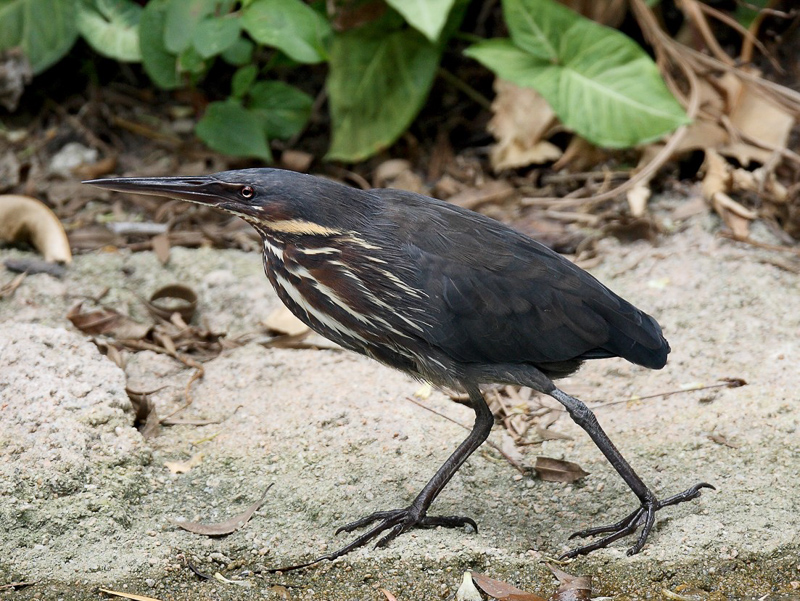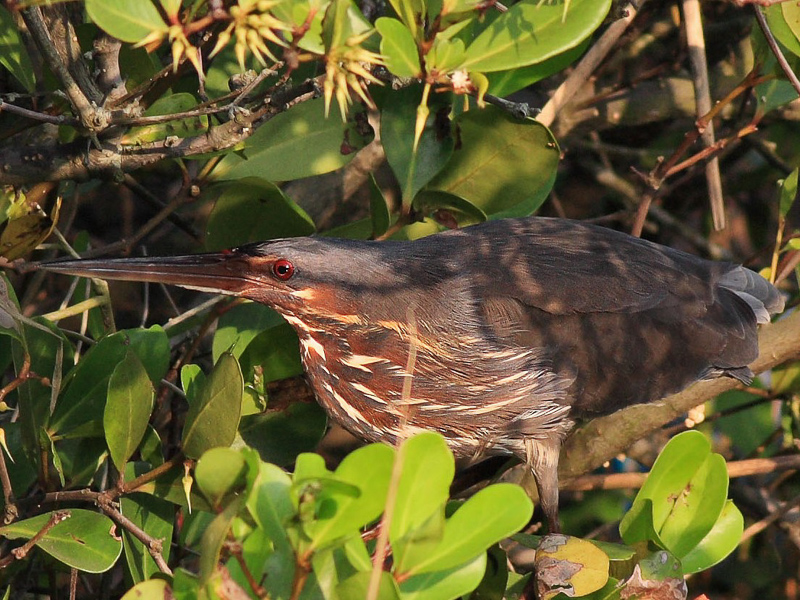Black Bittern Ixobrychus flavicollis 黑鳽
Category I. Scarce passage migrant to freshwater wetlands, occasionally seen on migration over the sea.
IDENTIFICATION

Jun. 2009, Michelle and Peter Wong. Adult male.
54-66 cm. Larger than other Ixobrychus herons in HK and closer in size to Black-crowned Night Heron. Adult males have very dark, blackish upperparts, yellowish sides to the neck and broad black streaks on the underparts.

May 2008, FUNG Hon Shing.
Females are browner and slightly paler than males, have a more extensive yellowish wash on underparts and deep chestnut in the underpart streaking.
Juveniles are substantially paler and rather variable in colour above, ranging from rufous to deep brown, with pale fringes to the wing coverts, yellow eyes and brownish-grey legs and feet. The underparts are densely marked with mahogany brown streaks.
VOCALISATIONS
The song recorded in Indonesia resembles that of Collared Scops Owl
DISTRIBUTION & HABITAT PREFERENCE
Occurs in widespread locations, including typical freshwater wetland sites such as Mai Po, Lok Ma Chau MTRC wetland mitigation area, Kam Tin and Long Valley, the migrant hotspot of Po Toi (from where diurnal migration over the sea can occasionally be observed), Cape D’Aguilar during the close approach of a tropical storm in mid-September 1999 and a variety of other, occasionally urban, sites throughout much of HK.
OCCURRENCE
First recorded during 26-27 May 1979, up to 1998 there were 20 records of Black Bittern, four of them forming part of a typhoon-related influx at the end of May 1989. Since 1999, with increased observer activity Black Bittern has occurred annually as a scarce passage migrant in spring and autumn. Apart from two very early records on 9 March 2008 and 17 March 2005, the earliest spring date is 23 April 2009 when one was seen to arrive at Po Toi. Main spring passage occurs in May, with the second half of the month seeing most records (Figure 1). There are a few June and July records reflecting the fact it breeds elsewhere in south China. Autumn passage is apparent from the middle of August, peaking in the second half of September. The latest autumn record is one at Kam Tin on 6 November 2008. All records have been of one or two birds apart from 11 on 15 September 1999 during the close approach of a tropical storm and eight on Po Toi on 21 May 2008.
It is of interest that Vaughan and Jones (1913) stated that Black Bittern was a summer visitor to the Pearl River delta, though it was ‘much the rarest of the … breeding species’ (among Cinnamon Bittern and Yellow Bittern). They stated that it arrived in early May and remained until October. Breeding sites were found at Kong Mun, near Macau, where it bred in company with the two other species, and at another site nearby. Herklots (1932) regarded Black Bittern as not proven to occur in HK; neither did Dove and Goodhart (1955) record the species. By the late 1960s, however, it is evident from descriptions in HKBWS files that confusion had already set in regarding separation of this species from Black-crowned Night Heron. Although the picture is thus somewhat unclear, and it may simply be that Black Bittern was always rare in HK, it seems likely that it declined significantly in the Pearl River delta area after the time of Vaughan and Jones. There have been no records suggestive of breeding in the area since then.
BEHAVIOUR, FORAGING & DIET
A secretive heron usually seen in flight when flushed.
RANGE & SYSTEMATICS
Breeds in Pakistan, north India along the southern flanks of the Himalayas, Indochina and south China south to the Philippines, east Indonesia, New Guinea and Australia; northern populations are migratory, wintering in peninsula Malaysia, west and central Indonesia and Borneo (Martínez-Vilalta et al. 2020). In China, a summer visitor from the Chang Jiang (Yangtze River) floodplain south, though not in the southwest or southeast coastal areas (Liu and Chen 2020).
Three subspecies are recognised, of which the nominate occurs from India through Indochina to south China, the Philippines and west and central Indonesia. To the east of here as far New Guinea and Australia occurs I. f. australis, while I. f. woodfordi is resident on the Solomon Islands.
CONSERVATION STATUS
IUCN: Least Concern. Population trend decreasing.
Figure 1.

Dove, R. S. and H. J. Goodhart (1955). Field observations from the Colony of Hong Kong. Ibis 97: 311-340.
Herklots, G. A. C. (1932). The birds of Hong Kong. Part XI. Family Ardeidae. The Herons, Egrets and Bitterns. Hong Kong Naturalist 3: 155-161.
Liu, Y. and Y. H. Chen (eds) (2020). The CNG Field Guide to the Birds of China (in Chinese). Hunan Science and Technology Publication House, Changsha.
Martínez-Vilalta, A., A. Motis, and G. M. Kirwan (2020). Black Bittern (Ixobrychus flavicollis), version 1.0. In Birds of the World (J. del Hoyo, A. Elliott, J. Sargatal, D. A. Christie, and E. de Juana, Editors). Cornell Lab of Ornithology, Ithaca, NY, USA. https://doi.org/10.2173/bow.blabit1.01
Vaughan, R. E. and K. H. Jones (1913). The birds of Hong Kong, Macao and the West River or Si Kiang in South-East China, with special reference to their nidification and seasonal movements. Ibis 1913: 17-76, 163-201, 351-384.

